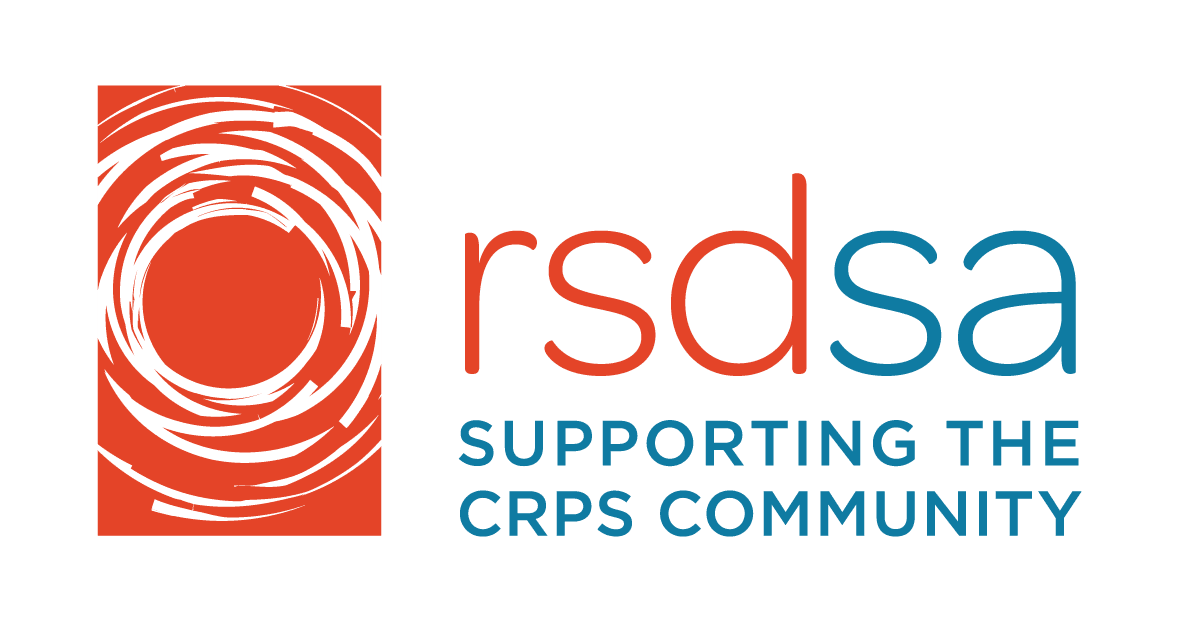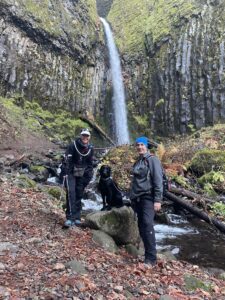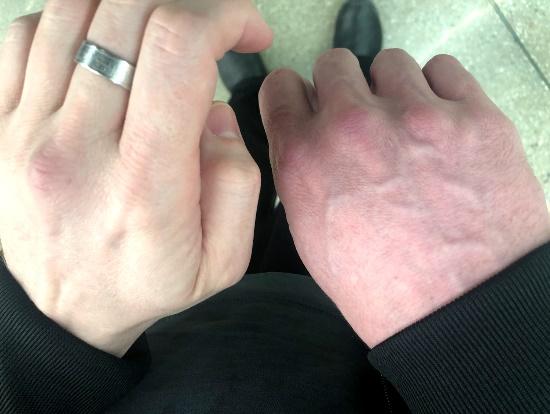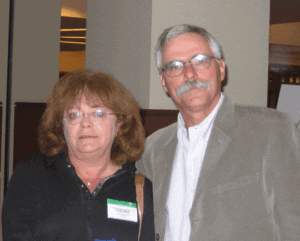Written by Jennifer Ferreyra for the RSDSA blog.
Helping others find their path is transforming to your own life, and one of the greatest blessings in mine. It’s about someone who’s already walked in your shoes reaching back and pulling you up out of the rabbit hole. It’s about love, hope, compassion and reducing pain in the worst of circumstances. Why do I care? I’ve been through my own living hell, not just CRPS, and I can’t leave someone in a similar condition if I can help. If anything that follows helps you I’m blessed. If not, please, keep searching for your formula, advocate for yourself and don’t give up.
My CRPS Pain
My CRPS, started in late December of 2016 at age 53 with a severe, raw, lighting bolt-like onset after I thought I paid my dues to cancer 26 years earlier. I absolutely refuse to lose to this disease which produces the most excruciating pain known to man even at the slightest movement or touch.
I share your pain, your tears, screaming, years of personal research, uneducated doctors, unnecessary medications, EMG tests, blurred vision, photophobia, MRIs, CT scans and years of no meaningful resolution. And please, allow me to point out that the smiley face pain level chart in the doctor’s offices is almost offensive to a CRPS patient.
Each of our CRPS pain and torture is different. Maybe I’m lucky that my pain is dedicated only to my left arm. We have little idea as to why it started except to say it was at a very stressful time in my life.
I have less of what is traditionally explained as gasoline burning, but rather a huge lighting bolt of severe nerve pain racing down my arm top to bottom, holding in the wrist, every two minutes. This includes lots of atrophy, skin scraping off like oatmeal, and brachial plexitis. Sleep? The longest I’ve gone without a stitch of sleep was five days at the Mayo Clinic hotel in Florida where absolutely no resolve was found, along with all the other hospitals I consulted with.
My first onset looked like my arm was a dead white corpse. I couldn’t take a step or move a muscle without triggering severe pain. This lasted almost three years and included the use of do nothing IV treatments, epidurals, anti-seizure medications, opioids, prednisone, and withdrawal, after which the pain was resolved for three years post acupuncture then came back. After a year, a new onset of the same pain returned. I submitted to an unsuccessful stellate ganglion block, and thirty days of implants that attempted to address the symptoms not the cause. By now I was a frequent flyer to the MRI and found it easier to keep my own hospital gown at home for dressing.
How RSDS.org Saved Me
I asked multiple doctors about a support group and to be directed to the authority on CRPS. The response was always “I don’t know.” It was then, still totally consumed by CRPS, that I started to advocate for myself and found RSDSA (founded over 40 years ago!) After seven years in pain, I spent hours reading every article, and watching every video trying to find out what causes CRPS and what pain management is working for patients that made the most sense to me. I learned that CRPS is a disease of the brain, not the limb, and that my doctors were indeed treating the symptom of pain not the cause. This made so much sense because I felt as if I had inflammation in my head for years.
As a result of seeing all the videos, I chose to march into my pain doctor’s office to request a drug referenced by some doctors and patients as successful – called Low Dose Naltrexone (LDN). He said, “oh, we can try that,” as if he already knew about it.
LDN apparently works with the Glia cells in the brain which is currently thought to be an important area of focus for CRPS. The Glia cells and nerves, relative to CRPS, are described in further detail by Dr. Pradeep Chopra in a Court TV trial presentation for the Maya Kawalski case on September 28, 2023 . You can also find information on Glia cells on rsds.org.
For me, 4.5 mg of LDN (less than $50 per month) showed immediate signs of success and took my pain from 12 to zero in a few months. I am now 16 months pain free. To start I had vivid dreams and mild headaches, which are expected. These subsided after a few months. My understanding is that Naltrexone does not work for everyone, but if it does or if you want to learn more, visit ldnresearchtrust.org, which I also found on my own. I have even emailed questions to the Trust and had return responses.
Rhetorically, why was I prescribed years of opioids that didn’t work and never told of LDN by any of over ten doctors anytime over seven years? Why did it take my own initiative in excruciating pain to find my own way? Why don’t doctors know about RSDS.org?
I strongly suggest reading and viewing everything on the RSDSA site. Advocate for yourself. Spend the time, in addition to your doctor consults. Take notes. See what resonates with you. It’s empowering.
Also keep an eye on the RSDSA YouTube Channel! https://www.youtube.com/@RSDSA
How I “Survived” Many Years of CRPS Torture
CRPS is a courageous fight of physical and emotional suffering. It’s like bleeding from a wound you can’t tell anyone about because they don’t understand. What follows is what aided me in surviving years of CRPS torture. I’ve broken this up so that you can eat the meat and spit out the bones as they say. None of this will fully resolve CRPS, but it was my path out.
Mindset
You must grab on to and not let go of even the smallest thing that takes your mind away from CRPS or any other problem you may have. This is one of the ways out.
Mindset is powerful. CRPS is a brain disease so this makes sense. And this is supported by multiple doctors. For years I found myself latching onto anything that would take my brain’s thoughts away from CRPS pain. Strangely enough, and even to this day out of pain, my cell phone is always with me set to something which will distract my brain from CRPS and other health issues. Music, TV, podcasts, even if I’m not cognitively listening to it. One of my consistent choices is The Today Show every weekday morning before work. This feels to me like I had friends with me every second and the anchors were uplifting. Even NFL and MLB games work.
I recently ran across a clip on Facebook where Jim Carrey describes being buried alive over the eight hours it takes to apply the Grinch make-up, which he did 100 times. The story goes on to say that he put his foot through his trailer wall on day one and quit because he couldn’t take it. A CIA operative with expertise on how to survive torture was hired to help. While I don’t prescribe to the methods mentioned, Jim did say that somehow every song the Bee Gees ever made got him through the eight hour make-up applications. I laughed out loud because those songs did the same thing for me with CRPS pain. It was something about the Bee Gees. Of course there were other songs, but whatever works for you on any given day.
Somehow music speaks to the spirit like words can’t. I heard someone recently say that “music gives organization to our emotions.” In our family, Spotify is the best $12 we spend every month. Almost any imaginable song that might work in a day is there and more. At night I leave the rain and ocean music on to help get me to sleep.
Mindset is often framed by time with friends, laughter, a photo in a magazine… find a way out and keep it going. Ups and downs are to be expected, but reward or praise yourself for even the smallest victories.
Look up Dr Philip Getson’s “The Optimist Creed”. This was recently shared on a slide in his March 6, 2025 Live Stream with RSDSA on YouTube.
Hope, Expectation, Perseverance
Do not be a bystander in your own life.
Hope is mandatory.
It’s painful to wait in the hope line, but you must hold onto even the smallest glimmer of hope in your brain. Even if it’s a piece of sand. Find it! You must work at this every day. Focus on it. There will be good days and bad days but you must continue to pull out of the defeatist attitude by latching onto any glimmer of hope, any positive path that your brain provides.
If you can only move one finger or toe, do it, and praise yourself so that your mind understands this is victory. Then add another victory, praise it and so on.
With perseverance and strength your minds perspective should change for the good and you’ll be encouraged to continue. Do not give up.
Food
Eat an anti-inflammatory diet, stay hydrated.
I’ve found that soy, alcohol, coffee, non-organic, and processed foods increase inflammation in my diet.
I’m lactose intolerant and removed soy from my diet with immediate positive inflammation changes. I now only drink organic almond milk, and organic products where possible. I completely stopped drinking coffee and alcohol which cause almost immediate inflammation in my head. I stay away from products where the first ingredient is generally entitled “enriched”which appears to be a proprietary cocktail of god knows what.
Heat/Cold – My Heated Vest, Lawn Lounge Chair Pad, Steam Shower and Hot Towel
There is so much to CRPS that we had to learn on our own. Not a single doctor told me that CRPS may be impacted by weather, barometric pressure, and that nerves don’t like cold until years into CRPS after I figured out how to cope for myself.
In spring, summer and fall, my outdoor lounge chair pad becomes hot in the sun and has been a wonderful aid to relax my muscles.
I can’t do without my heated fleece vests. I use Ororo brand but there are others. I wear the vest around the house and under layers when I go out in winter.
When pain starts I force my self into a warm shower which includes a steam shower. Heat warms my muscles, increases circulation and seems to put me on a better path. Do not sit and do nothing, you’re patterning your brain to accept the pain path.
In desperate times of pain I wet a hand towel, roll it, put it in the microwave and then throw it over my arm for moist heat. If it’s too hot, add a dry towel over it. Remove it before it becomes cold and start again.
Please note, CRPS also doesn’t like to be too hot, so it’s a balancing act. I’m constantly adding and removing layers on and off throughout a day.
Cut the Stress
When stress enters my life I immediately get non-painful shocks to my bottom lip and my entire nervous system starts shaking beneath my skin. I’m told this is also from the brain and likely from years of CRPS pain without resolve. I’ve had to choose between my health and unhealthy relationships. Be your own advocate and chose that your health comes first. For me this meant stepping back in full or part from certain relationships and events.
Call Me Crazy – Just For Fun
I DON’T RECOMMEND THE FOLLOWING, except for riding in the golf cart and staying active, but perhaps the following shows my level of commitment, or maybe just my stupidity. (Now I know you must be gentle with CRPS and full on golf may not be the way to do it.)
CRPS Onset #1 – Parenting: I’m a single parent and things had to get done. I would drive my car locally for two minutes, pull over and scream at the top of my lungs in pain, then drive for another two minutes and repeat. I conducted every aspect of my CRPS life with one arm for years. Made beds, did laundry, cooked food, shopped for food, worked a full time desk job, typed, even if it meant triggering level 12 pain.
CRPS Onset #2 – Golf: To pattern my brain for the better, I rode in a golf cart and didn’t play. As part of this plan, I didn’t anticipate actually playing, but that turned out differently. I went so far as to “play” golf in 10 of 10 pain for about three months until Naltrexone worked. I skipped any golf hole where someone other than my three golf friends were present. The pain would trigger when I hit the ball and I would yell a few choice four letter words and try to compose myself.
Going in and out of the golf course was okay. As long as I didn’t press on the left arm I could conduct conversations and nobody would know. If I felt pain coming, I would promptly excuse myself and try to get away fast.
Just sick. But as I said, I refuse to lose to this disease. And I refuse to let it take golf away from me.
Today
I’m 61 years old and 16 months out of pain on LDN which I expect to take for my lifetime. Over exertion causes severe exhaustion and shaking of my entire central nervous system. As I write, I have a persistent pinch in my back where my brain is recalling a years old mildly painful acupuncture needle. I’m addressing this by sitting on my yard lounge chair with a pad that is hot from the sun.
Being out of severe pain is a blessing, but I work hard every day toward ensuring my brain doesn’t recall the pain of what I hope is in the past.





